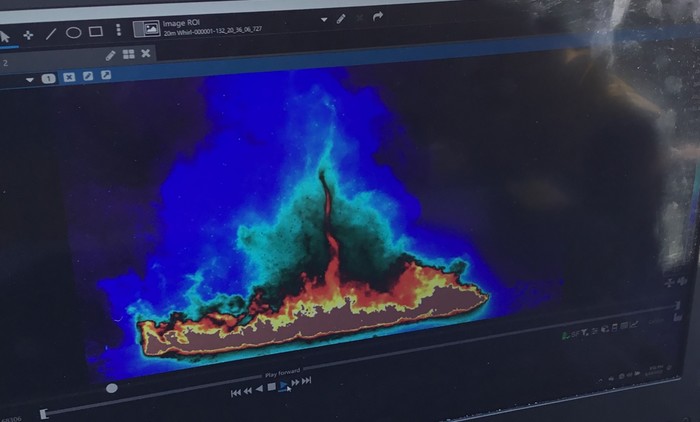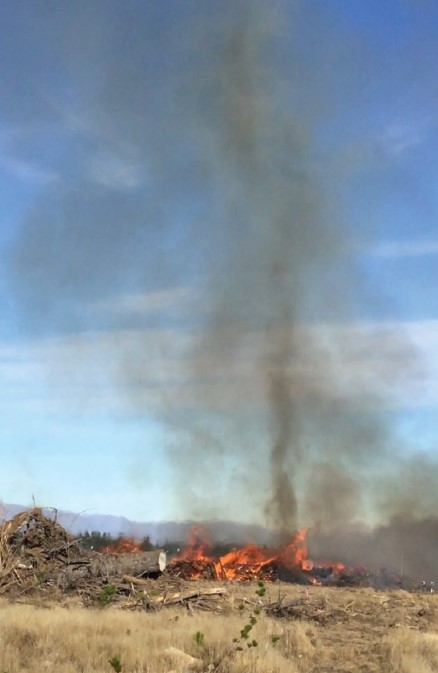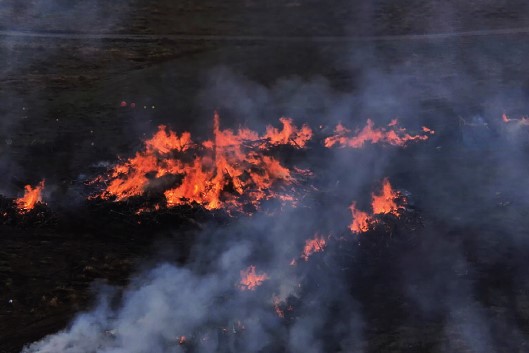Fire whirl research aims to safeguard firefighters
Alpine ranges leading to Aoraki / Mount Cook were the backdrop to world-first research where smoke devils and fire tornadoes took centre stage.
Scientists from Scion, USDA Forest Service, University of Canterbury and the US National Centre of Atmospheric Research achieved a world first by successfully generating fire whirls on slash piles near Twizel this year.

The activity was part of ground-breaking research aimed at protecting firefighters and communities from the devastating impact of future wildfire events.
Fire whirls/vortices, or fire tornadoes, occur during extreme wildfire events around the world, and are a major safety hazard to firefighters in the field. However, until May, they had never been deliberately created in the field and at scale.
The research team was made up of New Zealand and international researchers studying extreme wildfire behaviour as part of a programme funded by the Ministry of Business, Innovation and Employment (MBIE).
Jason Forthofer, a researcher with the USDA Forest Service, is a leading expert on wildfire vortices who has been studying fire whirls in a laboratory environment. He says generating a fire vortex had never been attempted anywhere in the world outside a laboratory before the experimental burns in New Zealand.
Scion science lead Shana Gross says the experiments were designed to isolate the fire whirl outside a wildfire and study the factors that cause fire whirls to form.
“We are still analysing the data, but we have learned that there are several elements that contribute to the formation of a whirl, including the fire’s configuration relative to wind, wind shear, fuel moisture and the high release of energy coming from multiple sources that intersect. We also know as the inflow increases, the probability of whirl formation decreases.”
A ‘watch-out’ situation observed at the experimental burn is to be aware of changes in smoke direction – if the horizontal smoke plume suddenly becomes vertical a whirl may form, Gross says.

Research collaboration
Scion’s strong relationship with Fire and Emergency New Zealand (FENZ) was a key factor in locating the research in New Zealand. The Twizel area was chosen because of the landowner’s support and the favourable experimental conditions that factored in topography, weather and vegetation. FENZ provided operational support during the field work, with crews from several Mid-South Canterbury volunteer brigades and the Department of Conservation onsite for each burn, helping to extinguish the piles once the scientists finished their monitoring and assessments. Each burn day also provided valuable training opportunities for FENZ, giving new team members exposure to incident management.
Twenty-four scientists were involved in the field work, with nine wilding pine slash piles of various sizes burned over four days.
After igniting the 20-metre-wide slash pile, the research team was able to generate a ‘smoke devil’ that took up the flame and generated a fire whirl. This whirl was the longest sustained whirl achieved during the research trials. Instruments on site recorded at 10 to 100 times per second.
The research group committed more than NZ$477,000 worth of sophisticated equipment to monitor, measure, and analyse the fire whirls. Data was collected using high speed thermal infrared cameras, visual cameras, UAVs, heli-kites and LiDAR technology on loan from San José State University. The team used the equipment to measure the temperature inside the fire whirl, the inward wind flow, and atmospheric conditions.
Boosting knowledge
In preparation for the experiments, four sets of wilding pine slash piles were established. The site was previously covered in wilding pines and was partially burned in the Pukaki Downs wildfire in September 2020.
The first of the burns took place on May 2 when five-metre diameter piles were ignited. The 10, 30 and 20 metre-diameter piles followed over different days. The team observed that even with low intensity fires, the smoke plume stood up despite continuous light wind, just before the vortex formed. This has previously been observed on large fires and scientists say observing it in lower intensity fires may indicate that this is a pattern that will hold in variable conditions.
Scion research lead Hugh Wallace says the experiments were a valuable data collection exercise.
“With every fire whirl experiment the team learned the sensitivities of the variables that produce fire whirls in forest debris and wilding pines.
“These burns were aimed at increasing our understanding of thresholds; atmospheric, environmental, fire intensity and fuel condition that must be crossed to generate a fire whirl. When these are understood, we can better predict their cause and spread.”

Global threat rises
Worldwide and in New Zealand, the occurrence of extreme wildfire is accelerating, affecting both rural communities and those at the rural-urban interface. The direct cost of wildfire on New Zealand’s economy in 2020 was $142 million. By 2050, this is predicted to cost $547m each year due to the changing climate.
While a growing number of fire whirls are being recorded globally, studying a fire whirl in a running vegetation fire is nearly impossible as so little is known about what triggers their formation, Forthofer says.
“Improving firefighter safety is always a top priority and this research helps by making it easier for firefighters to see when the conditions are right for a vortex to form.”
The activity was part of the Scion-led Extreme Wildfire Research Programme. With investment from MBIE, it runs until early 2026.
